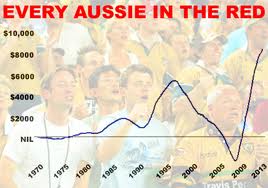A recent real estate article outlined why real estate in Australia was unlikely to crash. It then went on to list a number of reasons about Australia’s economy to support this argument. There were a couple of factors I agreed with, but a number of things were so wildly inaccurate I felt I had to respond. This is my responses to each point made. It doesn’t mean that Australian property prices will crash soon. But it doesn’t mean they won’t ever crash either, at some stage.
The bold text at the beginning of each point is a point in the article for a non crash. The text after the bold is my response.
- A depression or a severe recession unlikely. I and many other contrarian commentators disagree. I think a global depression or severe recession could be as likely as next year (2016). The world’s economies are slowing and the pace since the GFC has been lacklustre to say the least. There are too many variables to list here and include factors such as the Baltic Dry Index, which incidentally is at its lowest levels in decades, but any or all of these can impact on Australia’s and the global economies. Given the amount of money many countries have printed we should have absolutely booming economies, but we don’t. We instead have sluggish growth and many countries failing to get traction and slipping into and out of recession. The very thing that saved us during the GFC, China, is now the thing that will impact the most on us due to their slowing economy. Whatever happens outside Australia will impact on Australia internally. Even the IMF is continually adjusting growth figures down.
- Unemployment levels low. Now seriously! Does any thinking person still believe the data massaged, manipulated, “seasonally adjusted”, watered down, made politically more palatable figure the ABS releases as the unemployment rate is in any way accurate? The official figure is not measured the way it used to be, even as recently as the 1970’s. The Roy Morgan Research Study releases parallel unemployment level figures to the ABS. It’s figures paint a less rosy picture with unemployment at nearly 9% and the combined unemployed and underemployed figures as high as 17.4%.
- Interest rates rising. This one I agree with. Interest rates are unlikely to rise anytime soon. Actually, to quantify that, “official” interest rates are unlikely to rise soon. We should ask ourselves why interest rates are so low. Lowering interest rates are usually used by central bankers when a country’s economy is slowing or tanking, to try and stimulate it because confidence in the economy is low. Regardless of the fact that the last dozen interest rate cuts have not stimulated the economy and with each subsequent cut, the law of diminishing returns come into play (the effect is shorter and less effective), the RBA will likely cut interest rates again as our economy once again falters. There is a race to the bottom with low, zero or even negative interest rates thanks to currency wars and no country can actually afford to raise their official interest rates. The world’s economies are carrying so much debt, it is unlikely they can sustain an official interest rate rise, despite the US Federal Reserve Bank raising interest rates one whole quarter of one percent this month (December 2015). Also, it’s not the job of the RBA to “save” those who borrowed too much and then find themselves over their heads when real interest rates rise (see point 5 below).
- A huge oversupply of properties. This is most certainly the case in most major capital cities, as rent seekers try to find yield due to low interest rates, and look for it through other means, such as multiple dwelling development to maximise returns. This of course leads to a glut of attached stock, such as we are seeing in Sydney, Melbourne, Brisbane and possibly even Perth, which also has a glut of commercial property. Several commentators are on record as saying we are building too much of the wrong stock. The type of housing of which we need more is detached housing, small lot housing, aged care housing and housing that allow people to age in their own single level, no stair homes. These are not being built, as our Councils and state governments have become lazy and dependent on the easy money to be made from constructing block after block of flats.
- Credit market illiquidity or a credit squeeze. Australians currently hold record debt (which I will expand upon further in point 11). This has been possible due to foreigners being willing to lend more to Australian banks, partly due to our higher interest rates. When our interest rates drop too low, or global events make foreign investors nervous and are then no longer willing to lend money to Australia, real interest rates could rise above and beyond the level the RBA has set official interest rates. This has already happened in part due to the tightening lending criteria set by APRA. If public debt (government spending) becomes too high, it will make us unattractive to lend money to for the rest of the world. That coupled with high personal debt could threaten our AAA credit rating and real interest rates will rise regardless of what the official interest rate is. The ability of our banks to access foreign funds for lending is entirely outside of their control and as availability tightens, real interest rates rise.
- Robust population growth. Australia’s birth rate fell to 1.8 children per couple according to the most recent figures. It is heading to its lowest level in 20 years at 1.7 children per couple. We are not even replacing ourselves. Immigration is also slowing, and the type of immigrants are usually families. Families have lower housing requirements than singles, ie. one house can house a number of people just as easily as it can house a single person. This put downward pressure on housing requirements with less housing and rentals required.
- A healthy economy. Really? Based on what? Thanks to a slowing China, our mining boom is over, with record low commodity prices. We have a negligible manufacturing industry. Our service industries are struggling. Our governments and politicians would like to replace the mining boom with a construction boom, but all we build are more and more blocks of flats. How does property provide the long term productivity and ongoing employment that a real business provides? Once it’s built, it doesn’t employ many people consistently. We are not going to become wealthy selling properties to each other. This relies on the greater fool theory and eventually there is no greater fool. As the real unemployment and underemployed figures show, our economy is not really doing that great.
- A sound banking system. Once again, seriously! Our banks are overexposed to property, with some banks holding as much as 70% of its loans against property. Their investment in business, particularly small business, the real powerhouse employer, is negligible. They have belatedly begun to realise that if there are no businesses, there are no people to actually buy all these properties that are being built. How many people know that at least Westpac, Commonwealth, National Australia Bank, Bankwest and AMP among others, required bailout funds during the GFC under the US government’s TARP program? How many people realise that there was such a run on Australian banks during the GFC, that the Royal Australian Mint had to do emergency print runs to print more money because the banks were 24 hours away from running out of depositor’s money? Australian banks sound? Those in the know definitely know better, but it suits the banks, central banks and politicians to keep up that illusion.

- Business confidence. This can change in an instant. All it will take is a black swan event, or something that is outside our control, such as acts of terrorism, acts of war (we have a threat right on our doorstep with China and its claim of sovereignty over parts of the China Sea) or something else that is unexpected and the confidence mood will swing the other way. Australia is a commodity producing country, just like Canada and Brazil. These two countries are currently in recession, and Japan just went into recession again.
- Consumer confidence. Ditto as for business confidence.
- A healthy level of household debt. And again, seriously, are you kidding! We currently hold record levels of household debt. We have half as much again as we had during the GFC, which was a debt crisis. A recent Barclays survey listed Australian households as amongst the most indebted in the world. The ABS reported Australian personal debt reached record levels at $1.8 trillion for the country, or nearly $80,000 for every person. Household debt as a percentage of disposable income is at all-time highs at over 175%. That is definitely NOT a healthy level of household debt. The number of mortgaged homes is increasing and the number of homes owned outright is decreasing. Based on these facts and figures, if some households have no debt, it means that others are extremely overleveraged and overexposed and extremely vulnerable to a downturn.

- Property prices growth slowing. Property prices growth is slowing, and I believe we are reverting back to the mean of property prices increasing in line with inflation, which is what it does in a properly functioning economy. As we are now in what is most likely a low inflation and low interest rate environment, and which is unlikely to change in the near future, we are making our way back to the new normal. The parabolic capital gain asset price rises are only a product of the past 46 years since the decoupling of currencies from gold and the easy availability of credit. Before that, property prices, adjusted for inflation, were fairly flat.
The point is, nobody knows what is going to happen in the future. We are in uncharted territory, we do not have any precedent for what might happen next apart from the fact that no fiat currency has ever lasted beyond a couple of generations and creating money ex nihilo and ad infinitum has always ended badly throughout history. Maybe property prices will crash and maybe they won’t. We could continue on as we have been for another 20 years, or it could all collapse in a heap next week. We do have a very large investment stake in what is essentially a non-productive consumption item and we are not immune from corrections. However, as economist, John Maynard Keynes observed, the market has the ability to remain irrational longer than we can stay solvent.
Click to see article on LinkedIn


